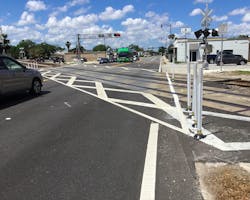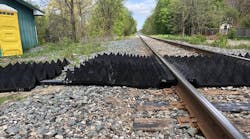Incidents at grade crossings and involving trespassers are not new to railroads, but the reasons for an increase in these incidents have shifted, making the industry find new ways to address these issues. While an increase in mental health awareness campaigns have helped address intentional rail fatalities, another problem has surfaced: distracted behavior.
According to the Federal Railroad Administration (FRA) Office of Safety Analysis, there were 597 nonfatal trespassing incidents from Jan. 1, 2019 through Oct. 30, 2019 and there were 535 fatal trespassing incidents for the same timeframe. And in Florida alone, FRA reports there were 106 grade crossing incidents at public and private crossings from January 2019 to October 2019.To combat this, industry stakeholders, including Operation Lifesaver, Inc. (OLI), the Florida Department of Transportation (FDOT), Brightline and L.B. Foster, are implementing a combination of engineering solutions and education campaigns that focus on improving rail safety.
Engineering a safer crossing
Florida is consistently one of the states with the highest number of grade-crossing incidents, according to the FRA, reporting 399 highway-rail crossing incidents for the calendar year of 2019. FDOT says one reason is people are stopping on the tracks without realizing. So, Brightline and FDOT turned their attention to at-grade crossings to help get people off the tracks.
Media Relations Director Michael Hicks explains Brightline installed 90 variable message signs (VMS) at the busiest intersections between West Palm Beach and Miami, displaying messages such as “See Tracks, Think Train.”
FDOT is focused on installing dynamic envelopes at every FDOT roadway and state-owned rail crossing. FDOT will also require dynamic envelopes to be included in the standard design of any future railroad crossings on FDOT roadways or state-owned land rail crossings.
The dynamic envelopes were piloted a few years back at two different locations, explains Secretary of the Florida Department of Transportation Kevin Thibault.
“When we did those [pilots], we saw a 15-percent improvement on people acknowledging they were in an active crossing, [so] you saw more of them staying away instead of them stopping in the middle of the rail crossing,” Thibault said. “We hope by employing [dynamic envelopes] at different locations, we’ll start to see that phenomenon more.”
And Thibault says this is just one tool to help improve rail safety. FDOT will also look into adding more signage in select locations, which could include more reflective signage to using updated technology and communications systems related to different signals.
Additional signage and dynamic envelopes aren’t the only engineering solutions out there. With more people exhibiting distracted behavior around railroad tracks, it’s easier for them to enter the tracks on foot without realizing. So, L.B. Foster developed an anti-trespass panel (ATP), which hit the North American transit and freight rail markets in 2019, according to Sarah McBrayer, assistant general manager of transit products at L.B. Foster.
“[The ATP] provides a passive deterrent to pedestrian foot traffic in the right-of-way, as well as areas such as platform ends where pedestrian are not permitted,” McBrayer said. “Various types of alternative, more rudimentary and makeshift solutions have been available in the past, but these tend to be nonfunctional.”
Made from 100 percent recycled rubber, the ATP has a cone design that provides an uneven walking surface and is available in three different styles. And according to a July 2019 FRA study that evaluated the effectiveness of the ATPs, they serve as an effective deterrent to trespassers.
“[The evaluation] of the ATPs on pedestrian behavior indicates that over a 60-day period–30 days before and 30 days after ATP installation–a 38-percent reduction in trespassing incidents was observed,” McBrayer said.
Education is half the battle
Finding effective engineering solutions and educating communities about rail safety is just half the battle, explains OLI Executive Director Rachel Maleh.
“Our work is really cut out for us because we are trying to change human behavior [too],” Maleh said.
This means pulling people away from their phone screens and paying attention to their surroundings to reduce the number of trespassing and near miss incidents, something OLI’s new PSA distracted behavior campaign is working towards, which lauanched in November 2019
“People are distracted on their phones,” Maleh said. “They're looking down, they’re listening to music or videos or even having phone conversations. People are more distracted than they were five to 10 years ago.”
The campaign targets 16- to 24-year-old males and will feature a social media rollout with 15 and 30 second clips of the campaign’s video, which shows a young male walking on train tracks with earbuds in not realizing a train is coming up behind him. The video ends with the slogan “the only thing that belongs on a track is a train” and reiterates how fast trains move and how much quieter they are now compared to a few decades ago.
To engage with younger audiences, OLI has also created a blog on their website for people to share their stories about a near miss incident which will then be shared on OLI’s social media pages, explains Chantez Bailey, director of communications and marketing at OLI, who notes the organization received the first entry detailing a personal near miss incident.
Maleh added how OLI has been using more human-interest stories for the organization’s videos so it’s not just statistics.
“That human interest story is really impactful and makes an impression on someone in a way that a chart with statistics, while equally compelling and tells a similar story, doesn’t have the same impact,” Maleh said. “So [for example], we will have videos of a mother talking about how her child was struck and killed because they were on the tracks taking selfies for their yearbook picture.”
In addition to posting the PSA to OLI’s and OLI’s partners’ social media feeds for the next two to three months, OLI is also working with Cook County, Ill., the FRA and OLI’s state coordinators for Illinois and Indiana on a grade-crossing pilot project that will measure the overall impact of the PSA marketing campaign and its effect on commuter behavior, says Bailey.
“OLI chose a high-risk area of trespassing…and worked within the state to consistently run the PSA campaign on various social media platforms and channels,” Bailey said. “…[We] hope to compare the number/statistics of trespassing incidents within a three-month time span in hopes that we find a decrease with reported incidents.”
Only trains belong on tracks
A combination of an engineering and education approach is required when it comes to addressing safety incidents on and near railroad property. Engineering solutions only go so far. While signals, gates and pavement markings warn people of their proximity to train tracks, it takes education to inform them what these visual cues mean and why it’s important to adhere to them. Additionally, educational outreach efforts teach people just how dangerous distracted behaviors can be for pedestrians on or near tracks.
“Near miss incidents can turn deadly and tragic and we want to show that,” Bailey concluded.

Megan Perrero | Editor in Chief
Megan Perrero is a national award-winning B2B journalist and lover of all things transit. Currently, she is the Editor in Chief of Mass Transit magazine, where she develops and leads a multi-channel editorial strategy while reporting on the North American public transit industry.
Prior to her position with Mass Transit, Perrero was the senior communications and external relations specialist for the Shared-Use Mobility Center, where she was responsible for helping develop internal/external communications, plan the National Shared Mobility Summit and manage brand strategy and marketing campaigns.
Perrero serves as the board secretary for Latinos In Transit and is a member of the American Public Transportation Association Marketing and Communications Committee. She holds a bachelor’s degree in multimedia journalism with a concentration in magazine writing and a minor in public relations from Columbia College Chicago.





